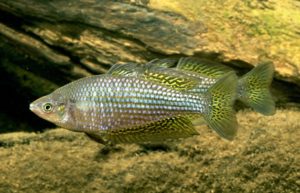
How life manages to persist in unpredictable and extreme environments is a major question in evolution. For aquatic animals, extreme environments include those with little water such as the deserts of central Australia.
Adaptations in the genome linked to the very dry conditions of the Australian outback ensure populations of desert fish survive in harsh conditions, according to scientists from Flinders University’s Molecular Ecology Lab and their collaborators from University Laval, in Quebec, and the University of Canberra.
The researchers focused on populations of Desert Rainbowfish (Melanotaenia splendida tatei) collected from across the Australian desert. Variations in the Desert Rainbowfish genomes were compared with data from satellite images about the presence of surface water in central Australia.

They found that populations from drier regions of the desert are more isolated and smaller, but also show stronger capacity to adapt to harsh and dry environments.
“This turns on its head traditional thinking that small populations are evolutionary dead ends. Life finds a way, even in the most extreme and unpredictable environments on Earth,” says Professor Luciano Beheregaray, Research Section Lead of Ecology, Evolution and Environment at Flinders University.

These findings presented in a new paper – Fish out of water: Genomic insights into persistence of rainbowfish populations in the desert, by Catherine Attard, Jonathan Sandoval-Castillo, Chris Brauer, Peter Unmack, David Schmarr, Louis Bernatchez and Luciano Beheregaray, published in the journal Evolution– are arguably the first in the world to explain how fish can survive and evolve in a desert environment.
Genetic diversity helps populations evolve in response to environmental changes, so maintaining a large gene pool is important – but understanding how small populations of desert fish survive, especially when located in isolated pockets of water, has remained a mystery.
“A small gene pool can lead to inbreeding and poor health, which is sometimes seen in endangered species,” says lead author Dr Catherine Attard, from Flinders University’s Molecular Ecology Lab. “However, we found that desert fish in Australia can hold on to life through adapting to harsh environments, then breeding and spreading during rare flooding events.”
The genes adapted to aridity can spread when the fish disperse along temporary streams and floodwaters. These fish and their adapted genetic make-up are then ready for the next drought.
The most intriguing difference was in a gene coding for a guanine nucleotide-binding protein. These proteins are used in fish for taste and smell, to detect salinity and water flow, and to control light sensitivity for vision. The different protein in fish from the arid western areas may improve their environmental sensors.
Genes adapted to aridity may allow species to persist as dry regions expand and have more extreme environmental fluctuations under future climate change.
“The results of our study suggest that adaptations and persistence of genetic diversity can take place even in small populations, as long as natural connectivity during floods takes place”, says Professor Beheregaray.
The findings that resilience to extreme environments evolves even in small populations has implications for studies of adaptation to climate change and for conservation science.

